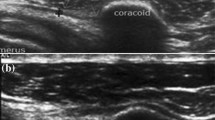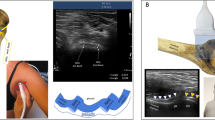Abstract
Patients with adhesive capsulitis were clinically evaluated to establish whether pain elicited by pressure on the coracoid area may be considered a pathognomonic sign of this condition. The study group included 85 patients with primary adhesive capsulitis, 465 with rotator cuff tear, 48 with calcifying tendonitis, 16 with glenohumeral arthritis, 66 with acromioclavicular arthropathy and 150 asymptomatic subjects. The test was considered positive when pain on the coracoid region was more severe than 3 points (VAS scale) with respect to the acromioclavicular joint and the anterolateral subacromial area. The test was positive in 96.4% of patients with adhesive capsulitis and in 11.1%, 14.5%, 6.2% and 10.6% of patients with the other four conditions, respectively. A positive result was obtained in 3/150 normal subjects (2%). With respect to the other four diseases, the test had a sensitivity of 0.96 and a specificity ranging from 0.87 to 0.89. With respect to controls, the sensitivity and specificity were 0.99 and 0.98, respectively. The coracoid pain test could be considered as a pathognomonic sign in physical examination of patients with stiff and painful shoulder.

Similar content being viewed by others
References
Abdullah Omari FRCS, Bunker TD (2001) Open versus surgical release for frozen shoulder: surgical findings and results of the release. J Shoulder Elbow Surg 10:353–357
Balci N, Balci MK, Tuzuner S (1999) Shoulder adhesive capsulitis and shoulder range of motion in type II diabetes mellitus: association with diabetic complications. J Diab Comp 13:135–140
Berghs BM, Sole-Molins X, Bunker TD (2004) Arthroscopic release of adhesive capsulitis. J Shoulder Elbow Surg 13:180–185
Boyler-Walker K (1997) A profile of patients with adhesive capsulitis. J Hand Ther 10:222–228
Bruchner F (1982) Frozen shoulder (adhesive capsulitis). J Royal Soc Med 75:688–689
Bunker TD, Anthony PP (1995) The pathology of frozen shoulder. J Bone Joint Surg Br 77:677–683
Bunker T, Esler C (1995) Frozen shoulder and lipids. J Bone Joint Surg Br 77:677–683
Cakir M, Samanci N, Balci N, Balci MK (2003) Musculoskeletal manifestations in patients with thyroid disease. Clin Endocrinol 59:162–167
Codman E (1934) The shoulder. Rupture of the supraspinatus tendon and other lesions in or about the subacromial bursa. Thomas Todd, Boston
Dias R, Cutts S, Massoud S (2005) Frozen shoulder. Br Med J 331:1453–1456
Duplay S (1872) De la peri-arthrite scapulo-humerale et des raideurs de l’épaule qui en sont la consequence. Arch Gen Med 20:513–514
Hand GCR, Athanasou NA, Mattews T, Carr AJ (2007) The pathology of frozen shoulder. J Bone Joint Surg Br 89:928–932
Hunt SA, Kwon YW, Zuckerman JD (2007) The rotator interval: anatomy, pathology, and strategies for treatment. J Am Acad Orthop Surg 15:218–227
Levine WN, Kashyap CP, Bak SF, Ahmad CS, Blaine TA, Bigliani LU (2007) Nonoperative management of idiopathic adhesive capsulitis. J Shoulder Elbow Surg 16:569–573
Massoud SN, Pearse EO, Levy O, Copeland SA (2002) Operative management of the frozen shoulder in patients with diabetes. J Shoulder Elbow Surg 11:609–613
Neer C, Satterlee C, Dalsey R, Flatow E (1992) The anatomy and potential effects of contracture of the coraco-humeral ligament. Clin Orthop 280:182–185
Neviaser RJ, Neviaser TJ (1987) The frozen shoulder. Diagnosis and management. Clin Orthop 223:59–64
Ogilvie-Harris D, Biggs D, Fitsialos D, Mackay M (1995) The resistant frozen shoulder manipulation versus arthroscopic release. Clin Orthop 319:238–248
Ozaki J, Nakawaga Y, Sakurai G, Tamai S (1989) Recalcitrant chronic adhesive capsulitis of the shoulder: role of contracture of the coracohumeral ligament and rotator cuff interval in pathogenesis and treatment. J Bone Joint Surg Am 71:1511-1515
Plancher KD, Johnston JC, Peterson RK, Hawkins RJ (2005) The dimension of the rotator interval. J Shoulder Elbow Surg 14:620–625
Riley D, Lang A, Blair R, Birnbaum A, Reid B (1989) Frozen shoulder and other shoulder disturbance in Parkinson’s disease. J Neurol Neurosurg Psychiatr 52:63–66
Samilson RL, Prieto V (1983) Dislocation arthropathy of the shoulder. J Bone Joint Surg Am 65:456–460
Smith SP, Devaraj VS, Bunker TD (2001) The association between frozen shoulder and Dupuytren’s disease. J Shoulder Elbow Surg 10:149–151
Wiley AM (1991) Arthroscopic appearance of frozen shoulder. Arthroscopy 7:138–143
Author information
Authors and Affiliations
Corresponding author
Rights and permissions
About this article
Cite this article
Carbone, S., Gumina, S., Vestri, A.R. et al. Coracoid pain test: a new clinical sign of shoulder adhesive capsulitis. International Orthopaedics (SICOT) 34, 385–388 (2010). https://doi.org/10.1007/s00264-009-0791-4
Received:
Revised:
Accepted:
Published:
Issue Date:
DOI: https://doi.org/10.1007/s00264-009-0791-4




